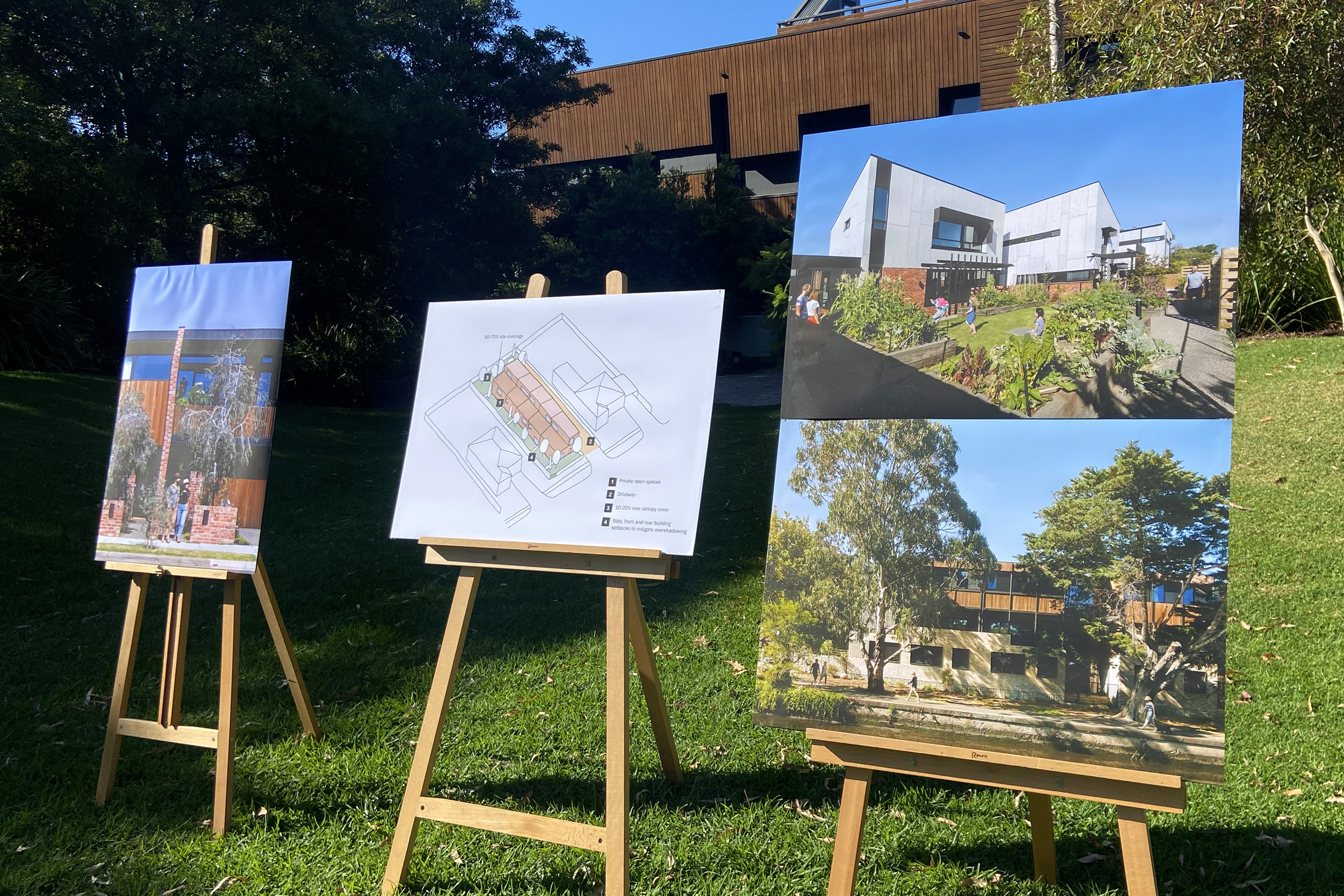You could get the impression that Australia’s most liveable city is on its way to becoming an urban hellscape.
“Jacinta Allan’s Undemocratic Plan to Destroy Melbourne’s Liveability and Quality of Life” was the title Victorian Liberal MPs’ gave to their chapter of a newly released report on planning reform. Their comments were adorned with a photo of a crowded, treeless metropolis. (A reverse image search suggests it was cropped from an unflattering picture of suburban Athens.)
Liberal upper house leader David Davis took up the theme when the report was tabled in the Legislative Council, predicting “the destruction of large parts of our Melbourne suburbs, our beautiful suburbs on which the ambience and history of our city is built.”
At issue are three amendments to Victoria’s planning scheme that go by the prosaic names VC257, VC267 and VC274. The first facilitates higher-density residential development around public transport hubs. The second codifies rules for multiple dwellings up to three storeys high on single lots and requires councils to approve compliant projects while denying nearby residents any right to object. The third creates a new “precinct zone” to streamline planning applications in priority areas, including around the stations on the Labor government’s suburban rail loop — a multi-billion dollar project to fundamentally reshape Melbourne for nine million residents by 2050.
Over the past month, a parliamentary committee dominated by non-government MPs has conducted a rapid inquiry into the amendments, with the Liberals hoping to convince the Greens to join them in disallowing the regulations in upper house. The attempt failed.
Not that the Greens are enamoured of the planning amendments either. They lament that higher densities were permitted without any trade-offs — especially any requirement to set aside a share of new dwellings for public housing or other “genuinely affordable” homes. And they say the amendments will reduce tree canopies and lower sustainable design standards across twenty-seven local government areas.
The planning amendments have ardent backers too. Researchers from the Grattan Institute warned that the Liberal bid to reverse the changes would be “a disaster for housing affordability.” Victoria, they said, would end up with fewer, more expensive homes, locking more Melburnians out of home ownership.
That argument rests on the proposition that planning constraints prevent developers from building enough homes. According to Grattan’s research, more than 40 per cent of residential land within ten kilometres of the CBD is zoned at the most restrictive level — the Neighbourhood Residential Zone — making it very difficult to build townhouses and apartments in the most desirable parts of the city. The result, according to the institute’s submission to the inquiry, is that population numbers are falling in “swathes of suburbs in Melbourne’s affluent east and bayside areas, precisely the places so many Victorians want to live, but can’t afford to.”
Grattan’s view that Victoria’s new planning rules “promise a bigger boost to the housing aspirations of younger generations than anything that occurs in the federal parliament” aligns with the “abundant housing” theory that inspires the lobby group YIMBY Melbourne. YIMBY (Yes in My Backyard) told the committee that the three planning amendments reflect best practice nationally and internationally and will “overwhelmingly benefit younger, poorer Victorians — particularly renters.”
The Liberal, Green and Legalise Cannabis MPs — a majority of the committee — were not convinced. The government, they found, failed to show that the planning amendments would increase the supply of housing, let alone make it more affordable. Indeed, they found it curious that one of the research papers provided by the Department of Transport and Planning revealed a lack of evidence that planning is what prevents housing getting built or that additional market-rate housing significantly affects affordability.
Local governments insist they are not holding back development, since they approve most planning applications within statutory time frames. Evidence that construction is yet to commence on tens of thousands of approved dwellings across Melbourne suggests home building is constrained by factors outside the planning system, including labour shortages, construction costs and high interest rates.
Abundant housing theorists would say this misses the point. While speedier approvals save time and money, the most important effect of Victoria’s three planning amendments is, as Grattan says, to “permit more housing where demand is highest.” This means more townhouses, apartments and other higher-density dwellings in suburbs currently dominated by low-rise detached homes. Before the amendments, Victoria’s planning rules blocked such change, and prioritised established residents and over future ones. The planning amendments don’t “dictate where housing must be built” but will, presumably, enable higher-density development to take off in Melbourne’s middle-ring suburbs once business conditions improve.
The committee reported that all the witnesses to the inquiry supported the Victorian government’s aim of building more well-located housing in Melbourne. Many, though, were concerned to protect heritage values and prevent the city’s urban fabric being overwhelmed by poorly designed, shoddily constructed apartment blocks. And many wanted the state to do more than rely on market forces to make housing more affordable.
There was a strong view among witnesses that the Victorian government had acted imperiously, failing to engage urban planners, design experts, local government officials and residents in meaningful consultation before making far-reaching amendments to the planning scheme. Charter 29, a group of professional planners, accused the Victorian government of conducting, “by stealth,” the most radical redrafting of planning in Australia’s history. Member Michael Buxton, emeritus professor of planning at RMIT, says the changes represent the capture of government by powerful property interests. Contrary to established practice, the amendments were not exhibited for public comment and expert review.
The committee found that planning minister Sonya Kilkenny “inappropriately exempted herself from expected consultation” (Kilkenny derided the inquiry as “a bit of a sham” and knocked back a request to appear without giving reasons) and that the Department of Transport and Planning failed to provide requested materials and background documents.
Rather than back the Liberal motion to disallow the amendments, the committee called for the impact of planning provisions to be monitored and constantly improved. This is in line with previous recommendations from the Victorian auditor-general — recommendations that have not been implemented.
The issues under scrutiny in the Victorian parliament are not specific to Melbourne. They bring to the surface tensions underlying the housing debates in all Australia’s capital cities — between present and future residents, between home owners and renters, between heritage and new housing, between building homes quickly and building homes well, between cost-cutting and community consultation, between neighbourhood concerns and metropolitan-wide interests, between the role of the market and the role of the state, between profit and public interest.
Committee chair David Ettershank, a Legalise Cannabis Victoria MLA, gave expression to these dilemmas in parliament: “It is abundantly clear that Victoria needs many more homes, especially more genuinely affordable homes, in well-located areas near public transport, jobs and services,” he said. “None of the committee members or indeed any of the witnesses who gave evidence to the inquiry dispute this cruel and pressing reality.”
Yet, he added, the “dramatic scope” of the planning amendments would have “many unintended consequences.” They were made on the promise of certainty and speed at the expense of the right of the community and local councils to have a say. “I do worry that the government is overlooking the benefits of consultative and collaborative engagement with councils and communities.”
“As one witness put to us, this is a once-in-a-generation opportunity to get it right; we must ensure that we do.” •




